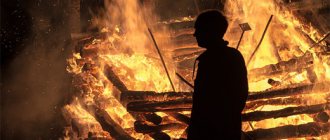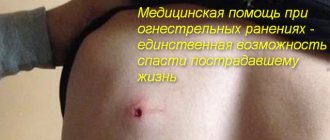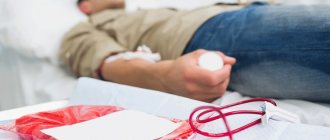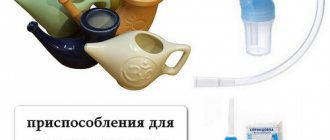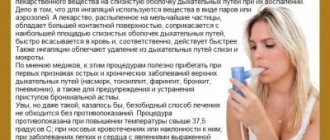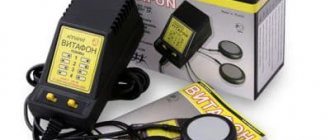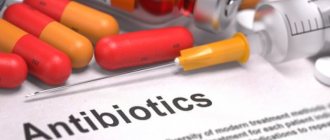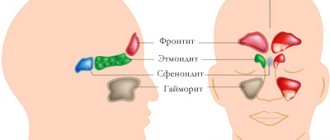Sometimes bleeding indicates the development of chronic pathologies that need to be treated.
Epistaxis or hemorrhage in the nasal cavity appears suddenly. Sometimes bleeding indicates the development of chronic pathologies that need to be treated. One of the features of epistaxis is suddenness. It is this that causes fear in the patient or others. In some cases, manifestations are isolated in healthy people and indicate a slight malfunction of the capillary. How to provide first aid for nosebleeds, and should you go to the hospital?
Types of blood loss
Epistaxis has its own classification, which evaluates the level of blood loss.
- Minor. If the mucous membrane is damaged, the patient loses several milliliters of blood, which is not a dangerous condition for health. If a child starts bleeding, it can cause him to become frightened or hysterical.
Losing a few milliliters of blood is not dangerous to health. - Moderate. From 100 to 200 ml of blood flows from the nasal mucosa. Bleeding causes a person to feel weak, dizzy, and dark spots appear before the eyes. The heart rhythm is slightly off, which is manifested by a rapid pulse. The skin turns slightly pale.
- Massive. At one point the patient loses up to 300 ml of blood mass. Symptoms become severe and the person’s condition worsens significantly. Tinnitus, thirst and shortness of breath are observed. If you do not provide first aid for such nosebleeds, there is a high probability of loss of consciousness.
- Profuse. Episticasis is characterized by a single loss of blood of more than 500 ml. This condition poses a serious threat to the entire body. A sharp decrease in pressure causes hemorrhagic shock. The patient quickly experiences a loss of consciousness and becomes lethargic. With this disorder, it is important to stop nosebleeds in order to prevent a lack of oxygen in organs and tissues.
Causes of bleeding
All damage to the nasal mucosa with further hemorrhage is divided into two types - local and general. The reasons for their appearance vary, but the result is the same - the capillaries in the nose are damaged, and blood begins to flow out of them.
Local bleeding
Injuries
With head injuries with septal disruption, hemorrhage can be profuse.
The damage was caused by a blow to the face. With head injuries with septal disruption, hemorrhage may be profuse, but not particularly dangerous. Mechanical disruption of the mucous membrane is caused by the fact that children often stick foreign objects into their nose. When providing first aid, you should not pull out sharp or large objects yourself.
External factors
These include heavy physical activity and prolonged exposure to the sun. In most cases, the causes are single, so it is enough to provide minimal first aid for minor nosebleeds.
Sun or heatstroke
In case of heatstroke, cold should be applied immediately.
These conditions can be dangerous to humans. First aid is applying a cold object. Under the influence of heat, the mucous membrane dries out, which leads to loss of capillary tone and their fragility. The walls burst, and this leads to moderate hemorrhage. When providing medical care, it is important to move the person to a cool place or shade.
Pathologies
Bleeding acts as a symptom against the background of a deep systemic disorder or in chronic diseases.
- Hypertension (crisis). When arterial or intracranial pressure increases, the tissues become overfilled with blood and large capillaries rupture. Both minor blood loss and profuse hemorrhage may occur. According to statistics, pressure changes occur after sleep. Epistaxis in hypertensive patients manifests itself in the morning.
- Chronic and acute rhinitis. Nosebleeds are sometimes caused by damage to the nostrils from a runny nose. Heavy blood loss is observed during sinusitis. The pathology causes a violation of the density of epithelial tissue, which leads to weakening of the capillaries. There are many reasons for rhinitis - ARVI, allergies, drug exposure. After measures have been taken to stop the bleeding, the patient needs to be examined by an ENT doctor.
Heavy blood loss is observed during sinusitis. - Papillomatosis or polyposis. Benign formations grow on the inner surface of the septum and other areas. The result of their appearance on the mucous membrane or back wall of the throat (larynx) is viruses. Microbes capable of mutation are especially dangerous. Polyps and papillomas compress tissue, which leads to frequent hemorrhages and even difficulty breathing.
- VSD. This general disorder is characterized by weakness and fragility of blood vessels. Vegetative-vascular dystonia is often observed in people in adolescence and in people with an asthenic body type. Bleeding can be watery and short-lived, but has a significant impact on quality of life if it occurs frequently.
- Atherosclerosis. A dangerous disease for blood vessels, which leads to their insufficient functionality. Pathology can provoke a complete loss of their elasticity. With atherosclerosis, there is a high probability of not only hemorrhages from the nostrils, but also the release of blood into the internal organs.
- Pheochromocytoma. The pathology is included in the group of kidney diseases, and is accompanied by a high release of hormones. This condition leads to constant pressure surges. With pheochromocytoma, nosebleeds occur frequently and lead to a deterioration in the general condition. Providing first aid for nosebleeds due to a tumor will not be enough. The patient is recommended to undergo a full examination and eliminate the cause of the capillary rupture.
With pheochromocytoma, nosebleeds occur frequently and lead to a deterioration in the general condition. - Taking medications. Sometimes medications interfere with clotting after prolonged use. People who regularly use thinning medications often suffer from nosebleeds. Also, heavy blood loss can occur due to the uncontrolled use of vasoconstrictor sprays and drops.
- Lack of vitamins. Epistaxis develops due to insufficient intake of vitamin C. This substance helps strengthen the walls of blood vessels. And if the nutrition is not balanced, the tissues become loose and brittle. An additional symptom is bleeding from the gums.
Forecast
The prognosis directly depends on the cause that provoked epistaxis. If the condition occurs frequently, you need to be examined to identify the disease. Chronic bleeding is usually caused by nasal infections, allergies, or a deviated nasal septum. Frequent blood loss can cause anemia and general weakening of the body. Once the problem is resolved, the bleeding stops.
Epistaxis extremely rarely leads to death, in less than 0.1% of cases.
Nosebleeds occur as a manifestation of illness or injury. In most cases, properly administered first aid helps stop the bleeding. If the problem recurs, you need to consult a doctor to find out the cause.
First aid for nosebleeds
The algorithm of actions during emergency care for nosebleeds is not complicated. If the condition becomes dangerous, it is better to take the patient to a doctor for further examination.
- The victim is seated or positioned so that the upper body remains elevated. It is forbidden to straighten your head too much; hemorrhage in the larynx may occur.
The victim is seated so that the upper body remains elevated. - Hydrogen peroxide (3%) or vasoconstrictor drops for a runny nose are dripped into the nostrils. If heavy bleeding prevents instillation of drugs, the use of tampons is recommended. They are pre-moistened in an antiseptic solution.
Hydrogen peroxide is dripped into the nostrils. - The patient should be at rest for about 15 minutes. For greater effectiveness, cold is applied to the bridge of the nose.
Precautionary measures
A patient with nosebleeds should not be placed down. This position will only increase the release of blood, which can enter the lungs or esophagus. It is also forbidden to blow your nose to clear the nasal passages of blood clots. This will lead to the blood clot breaking and re-bleeding.
First aid for nosebleeds in children is no different from that in adults, but parents need to coordinate the child’s actions. If the cause of the pathology is the ingress of a foreign object, it is prohibited to remove it yourself. Any such manipulation can further damage the mucous surface and increase bleeding.
If a tampon was used to stop bleeding, it should be moistened with hydrogen peroxide before removing it from the nostril. By pulling out a dry tampon, you can damage the formed blood clot, and the blood will flow again.
You should seek medical help if you experience frequent recurrences of nosebleeds. Also indicated are vomiting with blood in the patient, high blood pressure, the presence of pathologies that affect the formation and coagulation of blood, nasal injuries, and large blood loss.
How to treat?
Drug therapy
- After proper care is provided, the person will need treatment. Etamzilat, Epsilon and calcium supplements are good for bleeding.
Etamzilat, Epsilon and calcium supplements are good for bleeding. - In case of damage to the vessels of the posterior wall, drugs can be administered intravenously - aminocaproic acid, calcium chloride.
- Ascorutin is taken to strengthen the walls of blood vessels. Preparations containing snake venom are also used.
- After stopping heavy bleeding, it is important to replenish the plasma mass. To do this, specialists resort to drip administration of solutions or blood transfusions.
- Hypertensive patients are prescribed antihypertensive drugs, which can be used to stabilize blood pressure.
Surgical methods
Surgery is indicated for patients whose nosebleeds have frequent recurrences with extensive loss of plasma. The mucous tissue with vessels and the submucosal layer must be removed, sometimes the nasal septum is completely removed. If vascular growths are present, they are also excised.
Other methods
Cauterization
Coagulation is used if vascular weakness and insufficiency is congenital.
This method is used if vascular weakness and insufficiency is congenital. Any factors can cause bleeding from the nasal septum. Coagulation is carried out using electricity, laser or liquid nitrogen using local anesthesia. Before cauterization, the doctor completely clears the area of blood clots.
Tamponade
Blocking of nosebleeds is carried out in the anterior and posterior areas. This is first aid for major injuries or breakthrough bleeding that does not stop within 20 minutes. A bandage or hemostatic sponge is suitable for tamponing. The nasal cavity is filled from the posterior sections so that blood does not flow into the throat. After inserting tampons, be sure to apply a sling-shaped bandage. To prevent the development of infection, the bandage is first moistened generously with antiseptic and hemostatic solutions.
You can check the origins of the symptom
Bleeding that starts at the front of the nose is usually less severe and can be controlled by pressure (that is, by pinching the blood vessels). However, if your bleeding started from behind (that is, in a vessel located at the back of the nose), then such bleeding tends to be more severe and cannot be stopped simply by pinching the nostril. They are usually associated with large blood vessels, so you should go to the emergency room immediately.
Folk remedies
Thanks to traditional medicine recipes, you can provide first aid for nosebleeds at home. But all methods are not effective for complicated pathology. After providing first aid, you should seek further treatment from a doctor.
Common barberry
Use the tincture to rinse your nose three times a week.
With the help of the plant, you can strengthen the walls of blood vessels and get rid of periodic hemorrhages in the nose. It is enough to infuse 7 grams of crushed dry barberry in 250 ml of water. After the characteristic color of the liquid appears, it is cooled and the nose is washed three times a week.
Turnip
Raw turnips are grated, the juice is squeezed out and taken orally.
The vegetable is used for bleeding as an antimicrobial agent that suppresses the inflammatory process well. Raw turnips are grated, the juice is squeezed out and taken orally immediately after hemorrhage. The standard dosage is a tablespoon 2-3 times a day.
Horsetail
Horsetail decoction provides good assistance in the prevention of hemorrhages. To do this, a small amount of the plant is brewed in 500 ml of water. The drug is cooled to room temperature and the nose is washed or instilled generously.
Pathological bleeding requires immediate treatment. They pose a threat to health and significantly reduce quality of life. Be sure to use first aid in case of heavy blood loss.
Editor: Oleg Markelov
Rescuer of the Main Directorate of the Ministry of Emergency Situations of Russia in the Krasnodar Territory
More articles
